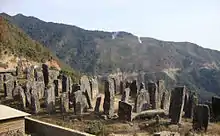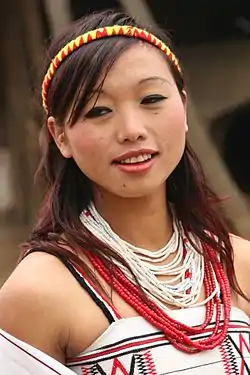Maram Naga
Maram tribe (1) is one of the tribes that form the Naga tribe of Northeast India. The Marams occupy a large portion of Senapati district of Manipur. They are the only tribe of Nagas who did not consume pork in the past; today, with the advent of Christianity, they have started changing their food habit and now almost 99% of the Marams consume pork. The Marams are known for their rich cultural heritage: traditional attire, folk songs, folktales, musical instruments, and so on. There are more than 30 Maram villages scattered in the geographical expanse generally known as the Maram Area. As per the 2001 census, the Maram Nagas numbered about 37,340 in total (Manorama Yearbook 2012, p. 576). According to UNESCO database on endangered languages, the Maram Language was among the list which amounts to only 37,000 number of speakers (based on India Census 2001). These figures, however, need further corroboration.
| Regions with significant populations | |
|---|---|
| Maram,Senapati District, Manipur, India | 10,911 (1988).37,300(2011)Directorate for Tribals and Backward Classes, Imphal[1] |
| Languages | |
| Maram language | |
| Religion | |
| Christianity Animism | |
| Related ethnic groups | |
| Other Naga tribes | |
The neighbours of the Maram Nagas are other Naga tribes: to the North are the Angami and Mao tribes; to the east are Poumai Nagas; to the South are the Thangal Nagas; to the South West are Zeliangrong Nagas (Liangmai); and to the West are Zeliangrong Nagas (Zeme).
Maram girls dressed up for "Mangkang" festival. The people speak the Maram language. There are some variations in the way the language is spoken; this corresponds with geographical contiguity.
For the sake of convenience and simplicity, they may be classified into five groups: those of Maram Khullen and its neighbouring villages; those of Willong and its surrounding villages; Villages in an around Tahamzam (Senapati); Tumuyon Khullen; and Ngatan villages.
Under the UNESCO’s classification of ‘degree of endangerment’ of languages, Maram has been put in the category of ‘vulnerable’; it means that "most children speak the language, but it may be restricted to certain domains (e.g., home)". So, it is not that bad if one were to look at it in terms of the spectrum of degree of endangerment which ranges from ‘vulnerable’ to ‘extinct’. If a language were to be categorized as ‘extinct’, it simply means that "there are no speakers left". True, the Maram language is not in immediate danger of extinction, but if the current neglect continues it might not be long before alarm bells start ringing.
Maram Khullen (also called Maramei Namdi) is the biggest and oldest Maram Naga village. The quintessential role of Maramei Namdi as the preserver of the tribe’s culture, social norms and ethos continues to hold sway. It zealously guards the many customs and traditions of the tribe. The people of this village continue to follow the "LUNAR" calendar for its customs and traditions. Willong is another Maram Naga village where, awareness about and practice of, traditional mores and culture is a prominent feature in the lives of the people.
The Maram Nagas use Roman script, as that of their own remains undeveloped. Not much is yet written about the people. This is therefore an opportunity for scholars who wish to undertake research, especially of anthropological nature.
Naga women dehusking paddy rice. Agriculture is the main occupation of the people. Women bear the major burden of household chores including taking care of children. Women will collect water and firewood. Men are responsible for cutting down of trees from which firewood are prepared. Both men and women are involved in rice cultivation: while digging of fields, sowing of seeds, transplantation of saplings, and harvesting are common activities, men are responsible for ploughing the fields.
The two major festivals of the Maram Nagas are Punghi (celebrated in July) and Kanghi (in December).
The Maram Nagas still maintain the age-old tradition of kingship. On 28 April 2011, K. Namba was crowned the new king of the Maram Nagas. Following the death of his father Karang, the king, his mother Apei Hinga had carried on the tradition as the Queen. The Queen too died on 27 August 2010. Since then, preparation had been on for the coronation of the new king. He is now officially called as Sagong Namba. Sagong in Maram language means king.
The King and Queen at the coronation ceremony. The geographical feature of the Maram area includes hills, scrub and tropical forest. Although the majority of the population have embraced Christianity, some still follow the traditional religion which may be characterized as a form of animism.
A simple way of locating the Maram Nagas is as follows: Asia – India – Manipur State – Senapati District – Maram Naga Tribe.
The following sentences will not make you an expert in the language, but it will definitely help break the ice in your interaction with the people. | Tingchoi kiibi (Good morning | Smoulai mak-ke (How are you?) | Halang takle (Thank you) |
Demographics

Marams are mainly found in the Senapti district of Manipur. According to the 1992 figures, the Maram Khullen was the largest village of Marams, followed by Willong.[1]
Division
Marams are found in the district of Senapati and its territory is spread across the sub divisions of Tadubi, Karong, Saitu, Saikul and Kangpokpi.
Culture
Ponghi, a seven-day festival of Maram Nagas, is celebrated on the 20th day of Ponghi-kii (July), when rice transplantation is completed, another very interesting festival of Maram tribe is "Mangkang". Mangkang is the biggest festival of women, Maram always have a great respect for women. Another major festival of the marams is the Kanghi. This is also a seven-day customary festival of Maram Nagas held in the month of Kanghi-kii (December). Wrestling is played during the festival in the Khullakpa’s compound in stark naked to get shy away the devils so as to obviate misfortune and injury.
Each lineages in traditional village of Maram has its own Sagong (King) but they are subject to the sagong of Lamkhana (Khullakpa Sagei) in matter of cult and morals. Sagong was the de facto and de jure head of the village. Every Sagongki (King's House) have their own morung (dormitory). Boy's morung is called Rehangki whereas that of the girl's is Raliiki.
The Marams are known for wet-rice cultivation on terraces of the hill slopes and the very small alluvial plain of the flat landform created by the deposition of sediment near river areas because of this labor-intensive cultivation, land is the most important form of property among them. This allows them to cultivate the same plot year after year however, to a small extent, on slash-and-burn cultivation is still done in small pocket mainly by the marams settled in southern region.
References
- Joseph Athickal (1992). Maram Nagas, a socio-cultural study (illustrated ed.). Mittal. pp. 2–5. ISBN 978-81-7099-354-4.
- "Maram Naga Tribe". blog.
- "Festivals". District Administration, Senapati District, Manipur. Retrieved 24 October 2011.
- http://www.e-pao.net/epSubPageExtractor.asp?src=manipur.Ethnic_Races_Manipur.Ethnic_Races_Sanathong.MARAM
Bibliography
- Joseph Athickal (1992). Maram Nagas, a socio-cultural study (illustrated ed.). Mittal. ISBN 978-81-7099-354-4.
